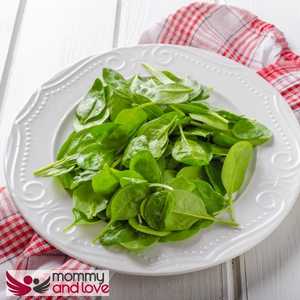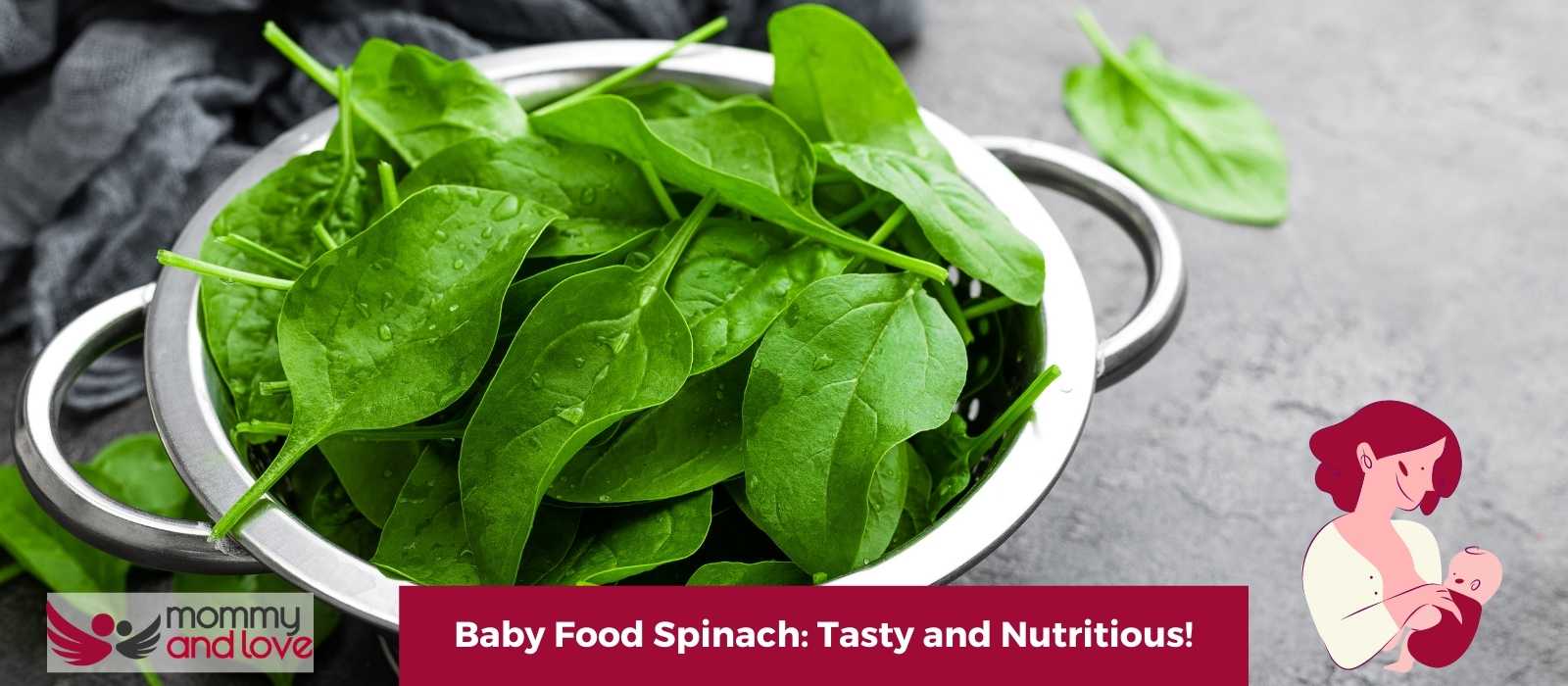Looking for nutritious and delicious baby food? Look no further than spinach! Spinach is packed with nutrients, including iron, calcium and vitamin A.
It also has a mild flavor that most kids enjoy, making it fantastic for baby-led weaning.
In this guide, we will discuss the benefits of feeding your baby spinach, as well as some recipes that you can try at home.
Can Babies Eat Spinach?
For babies, spinach can be a great way to get important nutrients into their diet. It is a good source of fiber, protein, and essential vitamins and minerals. Spinach is also low in calories, making it a perfect choice for babies who are trying to lose weight or maintain a healthy weight.
There are a few things you should keep in mind when feeding your baby spinach. First, make sure that the spinach is cooked properly. Babies under the age of one should not eat raw spinach, as it can contain harmful toxins. Cook the spinach until it is soft and then puree it or mash it up for your baby to eat.
Is Spinach Healthy for A Baby?

Spinach provides many nutritional benefits that are important for your baby’s growth and development. Spinach is a good source of protein, fiber, vitamins A, C, E and K, thiamin, riboflavin, niacin, calcium, iron, magnesium and manganese.
Baby spinach is said to be one of the best vegetables you can give your infant when they start eating solid foods.
What Are the Benefits of Spinach for Babies?
Spinach is an excellent source of dietary fiber, vitamin A, vitamin C, vitamin K, thiamin, riboflavin, niacin, folate, iron, magnesium, phosphorus and potassium.
Additionally, spinach contains beneficial plant compounds like lutein and zeaxanthin. All of these nutrients offer health benefits for both babies and adults.
- Fiber is important for digestion and helps keep us feeling full after eating.
- Vitamin A is essential for eye health and can help prevent childhood blindness.
- Vitamin C is important for immune system function and helps the body absorb iron from food.
- Vitamin K is necessary for blood clotting and healthy bones.
- Phosphorus and potassium are important for bone health.
- Magnesium helps regulate blood sugar levels and supports nerve and muscle function.
- Iron is essential for red blood cell production and can help prevent anemia.
How to Cook Spinach for Baby
You can cook this versatile vegetable in a variety of ways. It contains a good amount of iron which most infants and older toddlers need regularly in their diet to prevent anemia.
Spinach also contains a lot of other essential vitamins and minerals that are needed for healthy growth and development.
Spinach is also rich in folate, which contributes to the development of your baby’s brain and nervous system. Folate also helps form hemoglobin, the protein that carries oxygen in red blood cells and prevents birth defects.
When Can Babies Eat Spinach?
Once your baby is between 6 and 8 months of age, he may be ready to try solids. Spinach is an excellent choice because of its many health benefits, including a high content of vitamin C and iron.
The American Association of Pediatrics recommends that parents introduce solid foods to their children at about six months of age or when their child has doubled his/her birth weight and weighs at least 13 pounds (5.9 kg).
When you first introduce spinach to your baby, remember to offer the puree with other foods and not by itself.
This way, if your baby has an allergic reaction or does not like the taste of spinach, you will know which one caused it.
Is Spinach a Choking Hazard for A Baby?

Fresh spinach is not a common choking hazard. However, little children who are eating spinach should be watched to prevent choking. It has round difficult-to-chew leaves that can be a choking hazard.
Infants should be supervised while eating and not put in situations where they could choke. and they should not be left alone or put in a highchair without a harness, for example.
It’s a good idea to let them eat only finely chopped spinach until they are old enough to chew it safely.
Can Babies Be Allergic to Spinach?
It’s probably quite rare that a child would be allergic to spinach. Although the most common allergies in infants include eggs, milk, peanuts and tree nuts, other foods can cause allergic reactions as well. Signs of allergic reactions can include:
- Hives or rash
- Swelling of the face, lips or tongue
- Itching
- Wheezing or shortness of breath
- Vomiting or diarrhea
How to Choose and Store Spinach for Baby Food
When you’re choosing spinach for your baby, look for leaves that are dark green and smooth. Avoid spinach that is wilted or has yellowed leaves.
It is also a good idea to choose organic spinach since it is included in EWG’s dirty dozen list.
Store spinach baby food in a plastic bag in the refrigerator. It will keep fresh for up to five days. You can also freeze spinach by packing it into ice cube trays and freezing it.
Once it’s frozen, transfer the cubes to a plastic bag and store them in the freezer. You can use frozen spinach for future meals and recipes.
How to Prepare Spinach for Your Baby Food Recipes
Making spinach baby food is easy. Rinse spinach leaves well under running water. Some people like to soak the leaves for a few minutes in cold water as well. This will help clean and remove dirt from the leaves.
Wash your hands with soap and water before handling the spinach.
Gather fresh spinach leaves into a tight bunch and trim the bottom stems with a sharp knife or kitchen shears.
Spinach will work best in baby food recipes if it is chopped into smaller pieces or processed using a food processor, so you may want to do this after it has been steamed or sautéed.
If you don’t have a steamer basket, that’s okay. You can also blanch the spinach by putting it into a pot of boiling water for around a minute. The leaves will be tender and appear wilted when done.
How to make Spinach Puree for Babies
One way of introducing spinach to your baby’s diet is by making a puree. The cooking process of puree is simple and easy. Here’s what you need:
Ingredients:
- Washed and chopped fresh spinach
- Water or breast milk
- Salt (optional)
- Olive oil (optional)
Prep time: 5 minutes
Instructions:
Place the spinach and fresh water/breast milk (don’t use cooking water) in a blender or food processor. Add a hint of olive oil. Puree smooth or until desired consistency.
If you decide to add some apples, prepare the fruit by simmering it in water until fork-tender in a medium saucepan.
Serve immediately or freeze the spinach puree in the fridge for up to two days. You can use an ice cube tray, freezer bag, or an air-tight container.
Leftover Spinach Recipes for Baby-led Weaning
If you’re looking for some delicious and nutritious leftover spinach recipes for baby-led weaning, look no further! These recipes are perfect for little ones who are starting to explore solid foods.
There are lots of different ways to use leftover spinach puree for baby food. You can add the purée to pasta sauce, rice, soup, casseroles and other pot dishes.
Or your little one can eat spinach baby food puree straight up as a healthy snack or with other veggies such as sweet potatoes. If your baby loves the taste of cooked or pureed spinach, you can start to mix it with other purees.
Here are a few recipes that use leftover spinach:
Spinach and Feta Frittata:
This frittata is packed with flavor and nutrition. It’s perfect for a quick breakfast or lunch.
Ingredients:
- -leftover spinach
- -feta cheese
- -eggs
- -onion
- -garlic
- -salt and pepper
Instructions:
Preheat the oven to 350 degrees. Grease a baking dish with cooking spray. In a bowl, whisk together the eggs, feta cheese, onion, garlic, salt, and pepper. Pour the mixture into the baking dish. Top with the spinach. Bake for 15-20 minutes, or until the frittata is golden brown and cooked through.
Green Smoothie:
This smoothie is a great way to get your daily dose of fruits and vegetables. It’s packed with antioxidants, fiber, and vitamins.
Ingredients:
- -leftover spinach
- -banana
- -strawberry
- -orange juice
Instructions:
Place all of the ingredients in a blender and blend until smooth. Serve immediately.
Spinach Quiche:
This quiche is perfect for a quick and easy breakfast or lunch.
Ingredients:
- -leftover spinach
- -eggs
- -milk
- -cheddar cheese
- -onion
- -garlic
- -salt and pepper
Instructions:
Preheat the oven to 350 degrees. Grease a baking dish with cooking spray. In a bowl, whisk together the eggs, milk, cheddar cheese, onion, garlic, salt, and pepper. Pour the mixture into the baking dish. Top with the spinach. Bake for 30-35 minutes, or until the quiche is golden brown and cooked through.
These recipes are just a few examples of how you can use leftover spinach. Be creative and experiment with different combinations of ingredients to create your own recipes. The possibilities are endless!
Can I Use Frozen Spinach to Make Baby Food?
Yes, you can! It’s easy to use frozen spinach for baby food, and it has the added benefit of being more affordable than fresh spinach.
Simply thaw the desired amount of frozen spinach (we suggest using the microwave) and squeeze out any excess liquid or water.
Wash the spinach and then puree it with breast milk, formula, or water using a food processor or blender.
Spinach is kind of sweet so adding in some diced avocado will help bring out the natural sweetness in the spinach and make a nice creamy texture.
When preparing homemade baby food, always remember to wash your hands thoroughly before handling any produce or refrigerated items.
You should also always wash fresh fruits and vegetables before serving them to your little one, even if you plan on peeling them first.
Is Spinach Hard for A Baby’s Digestion?
Some parents believe that even cooked spinach is hard for a baby’s digestion. However, this is not necessarily true. In fact, spinach can be a great source of nutrients for older babies.
There are some things to keep in mind when introducing spinach to your baby. It is important to introduce new foods slowly and watch for any signs of digestive discomfort.
Also, spinach has high nitrate levels than other green vegetables. You can cook spinach alone and don’t mix it with other vegetables such as beets and collard greens which also have high nitrate levels and can lead to indigestion.
Faqs on Spinach for Baby
Why Can’t Babies Eat Spinach?
Babies cannot eat raw spinach under the age of 12 months. Raw spinach contains harmful toxins that can be dangerous for babies. Cook the spinach until it is soft and then puree it or mash it up for your baby to eat.
Can Babies Eat Sauteed Spinach?
How about boiled spinach? What about spinach in a smoothie?
The answer to all of these questions is yes! Babies can eat all different types of spinach, as long as it’s cooked until they are one year old.
Is Pureed Spinach Good for Babies?
Yes, pureed spinach is a great way to get babies started on the leafy green. You can mix it with other fruits and vegetables to create a delicious and healthy smoothie, or add it to your baby’s food purees.
Conclusion on Spinach for Baby
Spinach is a healthy source of nutrients.
Keep in mind that spinach can be hard on digestion, so introduce new foods slowly and watch for signs of digestive discomfort.
Spinach has more nitrates content than other green leafy vegetables which should not be mixed with other high-nitrate veggies such as beets or collard greens.
Pureeing spinach with breast milk, formula, or water is one way to cook it and can make it more digestible.
Freezing your spinach is one way to store it. You can add it to your baby’s food repertoire by thawing and squeezing out the excess water before making a puree out of it. More tips are available online so enjoy this tasty and nutritious spinach baby food!

This article was written by Sandra Baker – full time writer and the mother of four amazing kids (including twins!)
She’s also a breastfeeding counselor and has spent years helping new parents learn how to care for their children. When she’s not writing or caring for her children, Sandra likes to spend time reading and taking walks with her husband.




